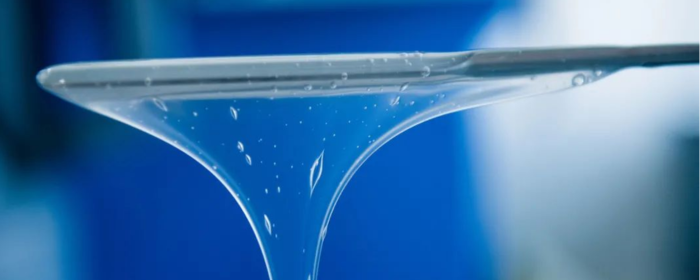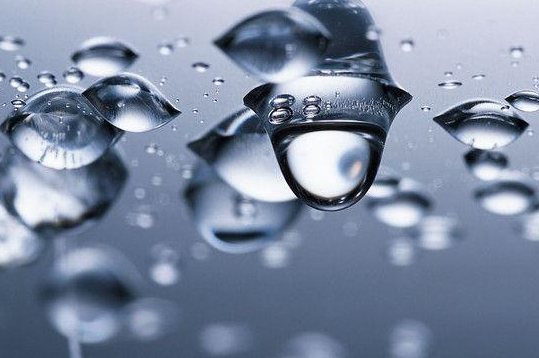
Hyaluronic acid (HA), with its unique molecular structure, exhibits significant viscoelastic properties.
1. What is Viscoelasticity
1.1 Conceptual Distinction: Viscoelasticity vs. Viscosity
Viscosity: Viscosity measures a fluid’s internal friction, with common units being Pascal-seconds (Pa·s) or Poise (P). It reflects the flow characteristics of HA. For example, high-viscosity liquids flow slowly (like honey), while low-viscosity liquids flow quickly (like water).
Viscoelasticity: Viscoelasticity describes the property of hyaluronic acid to exhibit both viscosity (flow) and elasticity (shape recovery) when subjected to stress or deformation. For instance, hyaluronic acid solutions behave like an elastic solid when stress is applied quickly and like a viscous fluid when stress is applied slowly.
1.2 Impact of Viscoelasticity on Hyaluronic Acid
Hyaluronic acid’s viscoelasticity significantly affects its performance and functionality in various applications.
Joint Lubrication: The viscoelasticity of HA plays a crucial role in joint lubrication. It reduces friction on joint surfaces (viscosity) and provides cushioning and recovery under pressure (elasticity). This makes hyaluronic acid an effective lubricant for treating osteoarthritis and other joint issues.
Moisturizing in Cosmetics: Hyaluronic acid’s viscoelasticity contributes to its moisturizing effects in cosmetics. It forms a hydration barrier on the skin’s surface, retaining moisture due to its viscosity, while its elasticity helps the skin remain soft and flexible under external pressure.
Tissue Engineering and Wound Healing: In tissue engineering and wound healing, the viscoelasticity of HA aids cell adhesion and migration. Its viscosity provides a favorable environment for cell attachment, and its elasticity supports the integrity and function of the tissue during healing.
Drug Delivery: Hyaluronic acid’s viscoelasticity allows it to stay in the body longer and release drugs slowly. Its viscosity ensures good contact with target tissues, while its elasticity allows the carrier to regain its shape after injection, enhancing drug stability and efficacy.
Aesthetic Fillers: In cosmetic surgery, hyaluronic acid fillers provide natural-looking results due to their viscoelasticity. Viscosity ensures stability at the injection site, preventing displacement, while elasticity allows fillers to remain soft and natural-looking with facial movements.
Biocompatibility: The viscoelasticity of HA also influences its biocompatibility. High-molecular-weight hyaluronic acid has better biocompatibility and lower immune response, making it safe and effective for medical and cosmetic applications. Its viscoelastic properties help reduce degradation speed in the body, prolonging its functional effects.
Clearly, the viscoelasticity of hyaluronic acid has profound impacts on its applications in the medical, health, and beauty fields.

2. What is Molecular Weight
2.1 Clarity of Concepts
The molecular weight of HA refers to the total mass of all atoms in its molecule. The molecular weight of hyaluronic acid can vary widely, ranging from a few thousand to several million Daltons (Da).
- Low Molecular Weight HA (LMW-HA): typically between 50kDa to 200kDa.
- Medium Molecular Weight HA (MMW-HA): approximately between 200kDa to 1,800kDa.
- High Molecular Weight HA (HMW-HA): generally between 1,800kDa to 2,000kDa, sometimes up to 6,000kDa.
Learn more: High vs. Low Hyaluronic Acid: How Molecular Weight Affects the Efficacy
2.2 Impact of Molecular Weight on Hyaluronic Acid
Different molecular weights result in different properties:
- Moisturizing Ability: High molecular weight HA, with its large molecular structure, forms a protective film on the skin’s surface to prevent moisture loss. Low molecular weight HA penetrates deeper into the skin, providing deep hydration.
- Permeability: Low molecular weight HA has higher skin permeability, reaching deeper skin layers effectively. High molecular weight HA mainly acts on the skin surface.
- Biodegradability: Low molecular weight hyaluronic acid degrades faster in the body, suitable for products requiring quick effects. High molecular weight HA degrades slower, providing longer-lasting effects.
- Immune Response: High molecular weight HA, due to its complex structure, typically has lower immunogenicity, making it suitable for medical uses. Low molecular weight hyaluronic acid may elicit a more noticeable immune response.
Different Applications Based on Molecular Weight
Low Molecular Weight HA has better skin permeability, and it is used in cosmetics and skincare products for deep hydration and anti-aging. Medium Molecular Weight HA offers good moisturizing and lubrication, commonly used in skincare products and joint lubricants. High molecular weight HA is used for joint lubrication and eye surgery. In contrast, low molecular weight HA is used to promote wound healing and tissue repair.
3. How Molecular Weight Affects Hyaluronic Acid’s Viscoelasticity
The length of hyaluronic acid’s molecular chains directly impacts its viscoelastic properties. Generally, high molecular weight hyaluronic acid exhibits long-chain structures, with complex molecular interactions and strong intermolecular forces. This results in high viscosity, high elasticity, and high viscoelasticity. Conversely, low molecular weight hyaluronic acid has short-chain structures with weaker intermolecular forces, resulting in low viscosity and low elasticity.
Stanford Chemical Company (SCC) is a pioneer in the development of hyaluronic acid. In addition to providing customers with food-grade, medical-grade, cosmetic-grade, and injectable-grade hyaluronic acid, we can also provide users with sodium hyaluronate powder with different molecular weights and viscoelasticity . For more information or specific applications, please visit our homepage.
